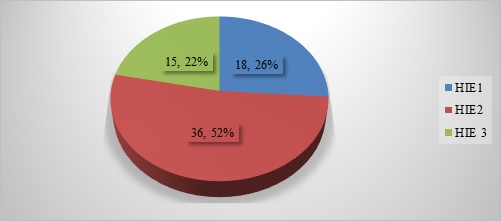To study renal parameters and serum calcium levels in birth asphyxia
Abstract
Background: Birth asphyxia is a common neonatal problem and contributes significantly to neonatal mortality and long term morbidity. Any organ can be affected but the brain, heart, kidneys are more sensitive to hypoxic injury.
Aim and Objective: To study renal parameters and serum calcium levels in birth asphyxia, to determine the incidence of renal failure in asphyxiated newborns, and to correlate the renal parameters with different severity of birth asphyxia and with different stages of hypoxic-ischemic encephalopathy.
Method and material: A comparative study of 69 term newborns, appropriate for gestational age born/admitted to tertiary care Centre RDGMC Ujjain with birth asphyxia and 69 normal newborns without birth asphyxia was done. Perinatal history, physical examinations, New Ballard score, Apgar score was done. Data collected and entered in the master chart for results and analysis.
Result: The study included 69 cases and 69 controls with the majority of boys. Mild, moderate, and severe birth asphyxia was7%, 29%, and 64% of all cases respectively. The incidence of acute renal failure was 57% among cases of birth asphyxia. The incidence of acute renal failure was 53% and 50% in hypoxic-ischemic encephalopathy stages III and II respectively. Incidence of renal failure with mild, moderate, and severe asphyxia was 40%, 50%, and 39% respectively
Conclusion: Perinatal asphyxia is an important cause of neonatal renal failure. Monitoring of urea, creatinine and urine output helps in the early diagnosis and management of acute renal failure
Downloads
References
Hansen AR, Soul JS. Perinatal asphyxia and Hypoxic ischemic encephalopathy in Manual of neonatal care. 7th ed India: Wolters Kluwer; 2011; 711-728;350-376.
Ilah BG, Aminu MS, Musa A, Adelakun MB, Adeniji AO, Kolawole T. Prevalence and risk factors for perinatal asphyxia as seen at a specialist hospital in Gusau, Nigeria. Sub-Saharan Af J Med. 2015;2(2):64.
World Health Organization. Perinatal mortality: a listing of available information. World Health Organization; 1996.
Network NN. National Neonatal Perinatal Database–report for the year 2002–2003. NNF NNPD network. New Delhi. 2005.
Agarwal R, Jain A, Deorari AK, Paul VK. Post-resuscitation management of asphyxiated neonates. Indian J Pediatr. 2008;75(2):175-180.
Lawn JE, Cousens S, Bhutta ZA, Darmstadt GL, Martines J, Paul V, et al. Why are 4 million newborn babies dying each year?. The Lancet. 2004;364(9432):399-401.
Lawn J, Shibuya K, Stein C. No cry at birth: global estimates of intrapartum stillbirths and intrapartum-related neonatal deaths. Bulletin of the World Health Organization. 2005;83:409-417.
Ahire NV, Patil SV, Patel ND, Sonawane R, Joshi D. A Comparative Study of Renal Parameters and Serum Calcium Levels in Birth Asphyxiated Neonates and Normal Neonates. MVP J Med Sci. 2017;4(2):97-101.
Vamne A, Thanna RC, Pathak S, Chavan N. A Study on Serum Calcium Level in Birth Asphyxia. Int J Health Sci Res. 2015;5(4):147-151.
Mac Donald HM, Mulligan JC, Allen AC, Taylor PM. Neonatal asphyxia. Relationship of obstetric and neonatal complication to neonatal mortality in 38,405 consecutive deliveries. J Pediatr 1980;96(5):898-902.
Chetty S, Kajjam SK, Patel A. Incidence of acute renal failure in birth asphyxia and its correlation with hypoxic-ischemic encephalopathy staging, Indian J Child Health. 2017;387-389.
Gupta BD, Sharma P, Bagla J, Parakh M, Soni JP. Renal failure in asphyxiated neonates. Indian Pediatr. 2005;42(9):928-934.
Mangi ZA, Bouk GR, Junejo B, Junejo A, Shaikh SH, Jamro S. Birth asphyxia relationship between hypoxic ischemic encephalopathy grading and development of acute renal failure in indoor term neonates at chandka medical college children hospital Larkana. Pediatr. 2009;15:148-152.
Aggarwal A, Kumar P, Chowdhay G, Mazumdar S, Narang A. Evaluation of renal functions in asphyxiated newborns. J Trop Pediatrics. 2005;51(5):295-299.
Jayashree G, Dutta AK, Sarna MS, Saili A. Acute renal failure in asphyxiated Newborns. Indian Pediatr. 1991;28(1):19-23.
Basu P, Som S, Das H, Chaudhuri N. Electrolyte status in birth asphyxia. Indian J Pediatr. 2010;77(3):259-262.
Sarnat HB, Sarnat MS. Neonatal encephalopathy following fetal distress: A clinical and electroencephalographic study. Arch Neurol 1976;33(10):695-706

Copyright (c) 2020 Author (s). Published by Siddharth Health Research and Social Welfare Society

This work is licensed under a Creative Commons Attribution 4.0 International License.


 OAI - Open Archives Initiative
OAI - Open Archives Initiative


